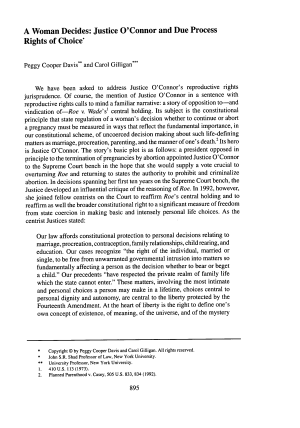A Woman Decides: Justice O'Connor and Due Process Rights of Choice
January 1, 2001

DISCLAIMER: This text has been transcribed automatically and may contain substantial inaccuracies due to the limitations of automatic transcription technology. This transcript is intended only to make the content of this document more easily discoverable and searchable. If you would like to quote the exact text of this document in any piece of work or research, please view the original using the link above and gather your quote directly from the source. The Sandra Day O'Connor Institute does not warrant, represent, or guarantee in any way that the text below is accurate.
Article Text
(Excerpt, Automatically generated)
A Woman Decides: Justice O'Connor and Due Process Rights of Choice*
Peggy Cooper Davis•• and Carol Gilligan•••
We have been asked to address Justice O'Connor's reproductive rights jurisprudence. Of course, the mention of Justice O'Connor in a sentence with reproductive rights calls to mind a familiar narrative: a story of opposition to-and vindication of-Roe v. Wade's I central holding. Its subject is the constitutional principle that state regulation of a woman's decision whether to continue or abort a pregnancy must be measured in ways that reflect the fundamental importance, in our constitutional scheme, of uncoerced decision making about such life-defining matters as marriage, procreation, parenting, and the manner of one's death.2 Its hero is Justice O'Connor. The story's basic plot is as follows: a president opposed in principle to the termination of pregnancies by abortion appointed Justice O'Connor to the Supreme Court bench in the hope that she would supply a vote crucial to overturning Roe and returning to states the authority to prohibit and criminalize abortion. In decisions spanning her first ten years on the Supreme Court bench, the Justice developed an influential critique of the reasoning of Roe. In 1992, however, she joined fellow centrists on the Court to reaffirm Roe's central holding and to reaffirm as well the broader constitutional right to a significant measure of freedom from state coercion in making basic and intensely personal life choices. As the
